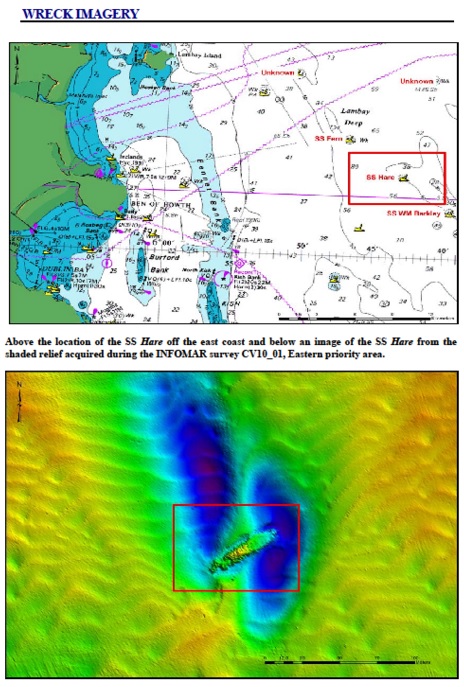The fun of the genealogy service in the National Library is that we never know in advance who we’ll meet, or what stories we’ll hear. Our job is to listen, to identify verifiable facts and events, and to guide enquirers in their research. The search never ends, because family history isn’t just about the past, it allows people to construct their own personal identity.
Here’s one of the stories we’ve heard from a recent visitor to the Library’s Genealogy Room.
On February 29th Austin Byrne dropped into the Genealogy Room looking for help to trace his great-grandfather William Byrne, who died in WWI.
On 14th December 1917 William Byrne drowned when the merchant ship, S.S. Hare, sailing en route from Manchester to Dublin, was torpedoed by a German U-boat. The ship sank within 3 minutes, about seven miles east of the Kish Lighthouse. Twelve lives were lost that night, although the captain survived. Because of war-time restrictions on reporting, there was very little newspaper coverage.
Austin had already completed a good deal of research, but failed to find a foot-hold before he came looking for help, to the Genealogy Room. Some of the sources he had already looked at included the Irish War Dead; the civil register of deaths; and various newspapers.
The name William Byrne is a very common Christian: Surname combination, and although Austin found very many men of this name, none of them was his great-grandfather. The sheer volume of records he had had to work through, to get to this point, made research difficult.
This is a common problem nowadays. The digital revolution of the last decade has resulted in tens of millions of family-history records online. Trouble is, with so many records, and so many common Irish names, it’s not always possible to see the wood from the trees; and to pick out your ancestor from their doppelgänger.
I started by checking the records of the military and armed services on Findmypast and Ancestry but found literally thousands of records in the name of William Byrne. I don’t like any search that is too ‘open-ended’ so quickly abandoned this method.
The Irish Newspaper Archive contains over 100 newspapers, and adds to the online-collection all the time. I began by browsing national and regional papers, limiting my search to six months after the S.S. Hare sank. Newspaper coverage was very scanty, possibly because of restrictions, but more likely because of the industrial scale of deaths in the trenches.
I found two accounts, both published on Friday 21st Dec. 1917:
The Derry Journal
The Dublin & Manchester steamer HARE has been sunk. She carried a crew of 21 men and was in command of Captain Carmichael. The vessel sank in 3 minutes after the crew had taken to their boats. A steamer passing the spot shortly afterwards heard shouts from the water and succeeded in rescuing [10 men, including the captain].
The Daily Express provided similar details, but added one critical detail.
The vessel carried a crew of twenty-one men and a stewardess, who was the only female on board, and is amongst those were lost…Mrs. Arnott, a widow.
I searched again, this time looking for the death of a Mrs. Arnott died in 1917. The name was sufficiently unusual, that the lady almost ‘jumped out’ of the records.
Mrs. Sarah Arnott, Death date 14 Dec. 1917, Crew, died on board the S.S. Hare. [Deaths at sea 1781-1965, BT 334 in TNA, available on Findmypast.com]
I called up this data-set, and realised that it’s possible to search by
- Christian and Surname:
- Birth Year;
- Death Year;
- Vessel name;
I searched for all 1917 deaths on board the Hare, and found the records of all crew members that drowned at sea when the S.S. Hare was torpedoed. These names were never apparently reported in any newspaper at the time of the sinking. Here are their names, and some brief identifying information.
- Sarah Arnott, Stewardess, 40 years (b. ca. 1877) born in Malahide, county Dublin.
- John Boyle, Fireman, 39 years, (b. ca. 1877) born in Dublin.
- William Byrne, Fireman, 40 years (b. ca. 1877) born in Dublin.
- Daniel Eley, Cook, 63 years (b. ca. 1854) born in London.
- Donald Gilchrist, First Mate, 37 years (b. ca. 1879) born in Islay.
- Joseph Hopkins, Sailor, 44 years (b. ca. 1873) born in Dublin.
- Lachlan MacFadyan, 58 years (b. ca. 1859) born in Tiree [?]
- Joseph Swords, 36 years (born ca. 1881) born in Dalkey county Dublin.
- Robert William Travers, Gun-layer [no age, no place of birth given in the records].
- Charles Walsh, Fireman, 33 years (born ca. 1884), born in Dublin.
- John E. Walters, Gunlayer, [no further information, age/ place of birth is recorded].
- James Wilson, First Engineer, 57 years (b. ca. 1860), born Midealder Edinburgh.
The wreck of the S.S. Hare lies (mainly) intact on the sea-bed, approximately 21 ½ Kilometres East of Howth Head. The final resting place of William Byrne and the eleven other crew-members is protected by the National Monuments Act.

I
by, Eneclann Research Expert
Fiona Fitzsimons